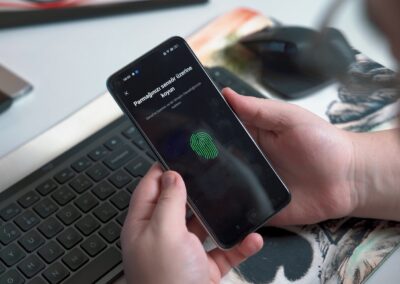Integration of Biometric Authentication in Mobile Banking: A New Era of Security
Understanding Biometric Authentication in Mobile Banking
In recent years, biometric authentication in mobile banking has emerged as a cutting-edge solution to enhance security and provide a seamless user experience. This advanced technology leverages unique biological traits such as fingerprints, facial recognition, and voice patterns to verify the identity of users. The integration of biometric authentication in mobile banking not only fortifies security measures but also simplifies the user experience, making it an attractive option for banks and their customers alike. In regions like Saudi Arabia and the UAE, where digital transformation is rapidly progressing, the adoption of biometric authentication is gaining significant traction.
Biometric authentication offers a robust layer of security that is difficult to replicate or breach. Unlike traditional methods such as passwords or PINs, biometric traits are unique to each individual, making it nearly impossible for unauthorized users to gain access to sensitive information. This increased security is particularly crucial in mobile banking, where users frequently conduct financial transactions on the go. By ensuring that only authorized individuals can access their accounts, banks can significantly reduce the risk of fraud and unauthorized access.
Moreover, the convenience of biometric authentication cannot be overstated. Users no longer need to remember complex passwords or carry physical tokens; a simple scan of a fingerprint or a quick glance at a camera is all it takes to log in. This seamless user experience is particularly appealing in today’s fast-paced world, where convenience is a key factor in user satisfaction. As a result, banks in Saudi Arabia and the UAE are increasingly adopting biometric authentication to enhance customer experience and foster trust in digital banking services.
The Role of Modern Technology in Biometric Authentication
The integration of biometric authentication in mobile banking is a prime example of how modern technology can transform traditional industries. Technologies such as artificial intelligence (AI), blockchain, and the metaverse play a crucial role in the development and implementation of biometric systems. AI algorithms, for instance, are used to analyze and verify biometric data with high accuracy, ensuring that the authentication process is both secure and efficient.
Blockchain technology further enhances the security of biometric authentication by providing a decentralized and immutable ledger for storing biometric data. This ensures that the data cannot be altered or tampered with, adding an extra layer of security to the authentication process. In the context of mobile banking, this means that users can trust that their biometric data is safe from potential breaches or cyberattacks. Banks in cities like Riyadh and Dubai are at the forefront of implementing these technologies to create a secure and user-friendly banking experience.
The concept of the metaverse, a virtual world where users can interact in a digital environment, also holds promise for the future of biometric authentication. In the metaverse, users can access their banking services through virtual avatars, using biometric authentication to ensure secure and seamless transactions. This innovative approach not only enhances security but also provides a futuristic and immersive user experience. As the metaverse continues to evolve, it is likely that biometric authentication will become an integral part of virtual banking services.
Biometric Authentication: Leadership and Management in Implementation
Leadership in Embracing Biometric Authentication
The successful implementation of biometric authentication in mobile banking requires visionary leadership and strategic management. Business executives and mid-level managers in Saudi Arabia and the UAE play a pivotal role in driving the adoption of this technology. By recognizing the potential benefits of biometric authentication, leaders can make informed decisions that align with their organization’s goals and customer expectations.
Effective leadership involves not only embracing new technologies but also fostering a culture of innovation within the organization. Leaders must encourage their teams to explore and experiment with biometric authentication, ensuring that the technology is integrated seamlessly into existing systems. This requires a proactive approach to training and development, equipping employees with the necessary skills to implement and manage biometric systems effectively.
Furthermore, leaders must also address potential challenges and concerns associated with biometric authentication. This includes ensuring data privacy and compliance with regulatory requirements, as well as addressing any ethical considerations related to the use of biometric data. By taking a holistic approach to leadership and management, executives can ensure that the adoption of biometric authentication is both successful and sustainable.
Project Management and Implementation Strategies
Effective project management is crucial for the successful integration of biometric authentication in mobile banking. This involves careful planning, execution, and monitoring of the implementation process. Project managers must collaborate with various stakeholders, including technology providers, regulatory bodies, and end-users, to ensure that the implementation meets all requirements and expectations.
One of the key strategies for successful implementation is to conduct thorough testing and validation of biometric systems. This includes pilot testing the technology with a small group of users to identify any potential issues and gather feedback. By addressing these issues early on, project managers can ensure a smooth and successful rollout of biometric authentication across the organization.
Additionally, project managers must also focus on continuous improvement and innovation. This involves staying abreast of the latest developments in biometric technology and exploring new ways to enhance security and user experience. By adopting a forward-thinking approach, organizations in Riyadh and Dubai can remain at the forefront of digital banking innovation, leveraging biometric authentication to drive business success and customer satisfaction.
Conclusion
The integration of biometric authentication in mobile banking represents a significant advancement in enhancing security and providing a seamless user experience. By leveraging modern technologies such as AI, blockchain, and the metaverse, banks in Saudi Arabia and the UAE can create a secure and user-friendly banking environment. Effective leadership and strategic project management are crucial for the successful implementation of biometric authentication, ensuring that the technology meets all regulatory requirements and customer expectations. As the digital landscape continues to evolve, biometric authentication will play an increasingly important role in shaping the future of mobile banking.
#biometricauthentication, #mobilebanking, #security, #userexperience, #SaudiArabia, #UAE, #Riyadh, #Dubai, #artificialintelligence, #blockchain, #metaverse, #generativeAI, #moderntechnology, #businesssuccess, #leadershipskills, #projectmanagement























